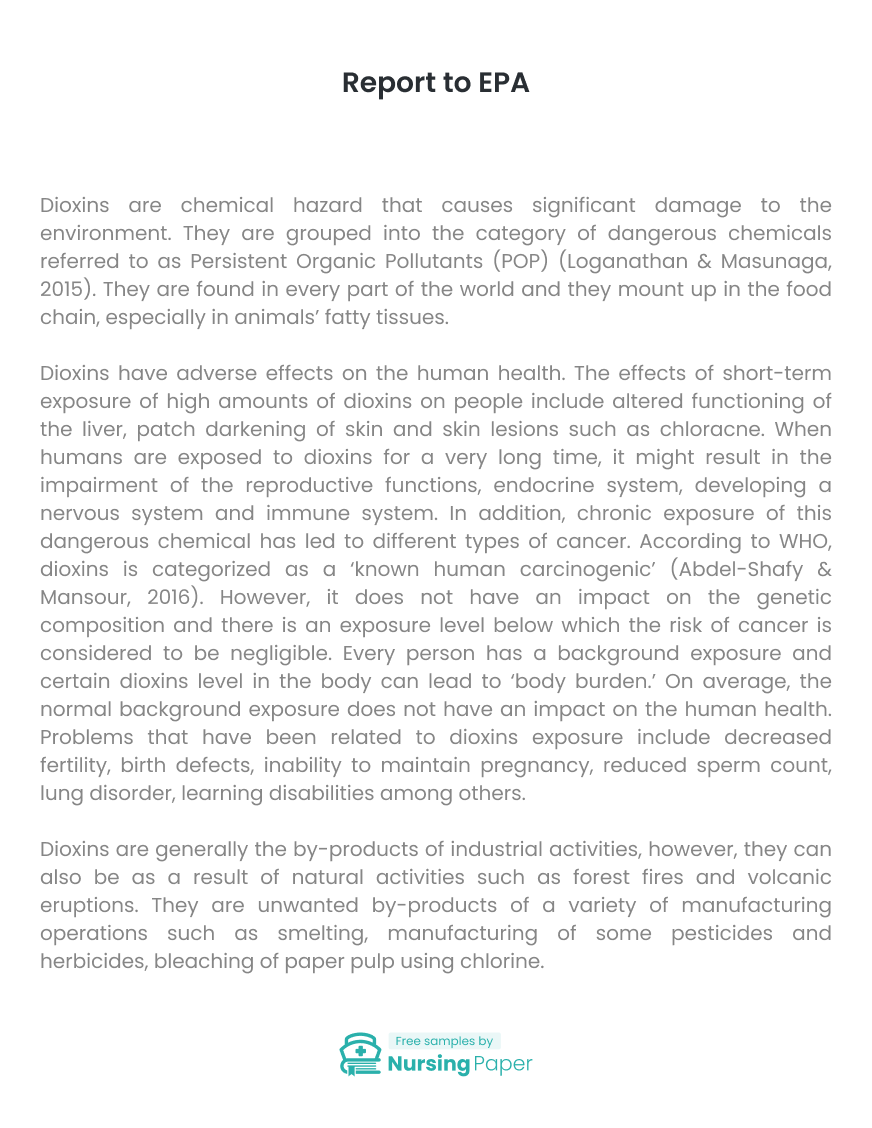
Report to EPA
Introduction
Dioxins are chemical hazard that causes significant damage to the environment. They are grouped into the category of dangerous chemicals referred to as Persistent Organic Pollutants (POP) (Loganathan & Masunaga, 2015). They are found in every part of the world and they mount up in the food chain, especially in animals’ fatty tissues.
Dioxins have adverse effects on the human health. The effects of short-term exposure of high amounts of dioxins on people include altered functioning of the liver, patch darkening of skin and skin lesions such as chloracne. When humans are exposed to dioxins for a very long time, it might result in the impairment of the reproductive functions, endocrine system, developing a nervous system and immune system. In addition, chronic exposure of this dangerous chemical has led to different types of cancer. According to WHO, dioxins is categorized as a ‘known human carcinogenic’ (Abdel-Shafy & Mansour, 2016). However, it does not have an impact on the genetic composition and there is an exposure level below which the risk of cancer is considered to be negligible. Every person has a background exposure and certain dioxins level in the body can lead to ‘body burden.’ On average, the normal background exposure does not have an impact on the human health. Problems that have been related to dioxins exposure include decreased fertility, birth defects, inability to maintain pregnancy, reduced sperm count, lung disorder, learning disabilities among others.


Dioxins are generally the by-products of industrial activities, however, they can also be as a result of natural activities such as forest fires and volcanic eruptions. They are unwanted by-products of a variety of manufacturing operations such as smelting, manufacturing of some pesticides and herbicides, bleaching of paper pulp using chlorine. Furthermore, uncontrolled waste incinerators (hospital and solid waste) release dioxins to the environment due to incomplete burning. Even though the production of dioxins is local, environmental distribution is worldwide. High amounts of dioxins compounds are present in some sediments, shellfish, soils and food. Lerner et al (2015), state that over 90% of exposure to humans is through food, mainly products of dairy and meat. Very low amounts are present in air, water and plants. In addition, improper disposal and long-term storage of dioxins might lead to its release into the environment and contaminate animal and food supplies. Human activities that lead to the production of dioxins include recycling and dismantling electronic products, production of herbicides and pesticides and other chemical processes and burning of household trash. Smoking of cigarette also has some small quantities of dioxins. Drinking water can have some dioxins components if it has been contaminated by industrial chemical processes.
The route of human exposure of dioxins for most of the population occurs mainly through diet, however, the exposure is of low levels. In addition, lower exposure can happen through coming into contact with water, soil or air. This can also occur when a person accidentally ingests soil that has dioxins compound, breathes in air or vapor that has trace amounts of dioxins and absorbing of dioxins through skin contact with water, soil or air. Furthermore, there have been concerned about dioxins present in plastic water bottles and sanitary products, especially tampons.
According to Roberts et al (2014), dioxins affect both the general public and occupational health. The public can be exposed to dioxins when they drink contaminated water or come into contact with contaminated air or soil. Employees working in industries and people living near industries that manufacture pesticides and herbicides are at risk of ingesting dioxins. Since some dioxins can be transported far when released into the air, they are thus able to affect the general public.

1. Abdel-Shafy, H. I., & Mansour, M. S. (2016). A review on polycyclic aromatic hydrocarbons: source, environmental impact, effect on human health and remediation. Egyptian Journal of Petroleum, 25(1), 107-123.
2. Lerner, C. A., Sundar, I. K., Watson, R. M., Elder, A., Jones, R., Done, D., … & Rahman, I. (2015). Environmental health hazards of e-cigarettes and their components: Oxidants and copper in e-cigarette aerosols. Environmental pollution, 198, 100-107.
3. Loganathan, B. G., & Masunaga, S. (2015). PCBs, dioxins and furans: human exposure and health effects. In Handbook of Toxicology of Chemical Warfare Agents (Second Edition) (pp. 239-247).
4. Roberts, S. M., James, R. C., & Williams, P. L. (2014). Principles of toxicology: environmental and industrial applications. John Wiley & Sons.



The download will start shortly.

The download will start shortly.
 Subject:
Health and Social Care
Subject:
Health and Social Care  Number of pages: 3
Number of pages: 3  Subject:
Nursing
Subject:
Nursing  Number of pages: 5
Number of pages: 5  Subject:
Health and Social Care
Subject:
Health and Social Care  Number of pages: 3
Number of pages: 3  Subject:
Nursing
Subject:
Nursing  Number of pages: 2
Number of pages: 2  Subject:
Medicine
Subject:
Medicine  Number of pages: 2
Number of pages: 2  Subject:
Medicine
Subject:
Medicine  Number of pages: 2
Number of pages: 2  Subject:
Medicine
Subject:
Medicine  Number of pages: 6
Number of pages: 6  Subject:
Health and Social Care
Subject:
Health and Social Care  Number of pages: 5
Number of pages: 5  Subject:
Health and Social Care
Subject:
Health and Social Care  Number of pages: 5
Number of pages: 5  Subject:
Health and Social Care
Subject:
Health and Social Care  Number of pages: 3
Number of pages: 3  Subject:
Medicine
Subject:
Medicine  Number of pages: 6
Number of pages: 6  Subject:
Health and Social Care
Subject:
Health and Social Care  Number of pages: 6
Number of pages: 6  Subject:
Medicine
Subject:
Medicine  Number of pages: 3
Number of pages: 3  Subject:
Health and Social Care
Subject:
Health and Social Care  Number of pages: 9
Number of pages: 9  Subject:
Nursing
Subject:
Nursing  Number of pages: 6
Number of pages: 6 
